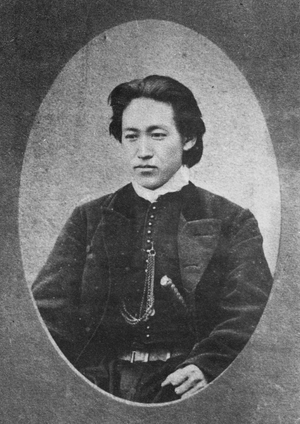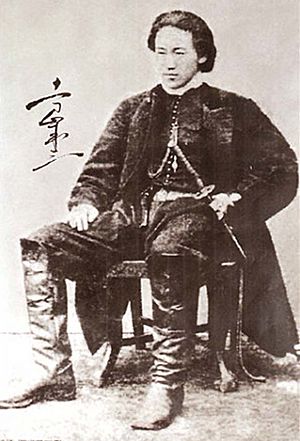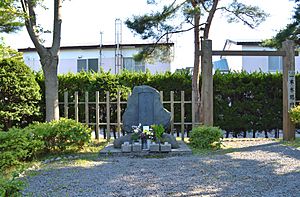Hijikata Toshizō facts for kids
Quick facts for kids
|
|
|---|---|

Hijikata in 1869, photograph by Tamoto Kenzō
|
|
| Native name |
土方 歳三 義豊
|
| Birth name | Hijikata Toshizō Yoshitoyo |
| Other name(s) | Naitō Hayato |
| Nickname(s) | Oni no fukucho (鬼の副長, "Demon Vice-Commander") |
| Born | May 31, 1835 Musashi Province, Japan |
| Died | June 20, 1869 (aged 34) Hakodate, Hokkaido, Japan |
| Buried |
unknown
|
| Allegiance | |
| Service/ |
Rōshigumi (former) Mibu Rōshigumi (former) Shinsengumi |
| Years of service | 1863–1869 |
| Rank | Vice-Commander Deputy Defence Minister |
| Battles/wars | Coup of August 18, 1863 Ikedaya incident Kinmon incident Boshin War
|
| Relations | Hijikata Yoshiatsu (father) Etsu (mother) Hijikata Tamejiro (brother) Hijikata Kiroku (brother) Hijikata Shuu (sister) Kasuya Ryojin (brother) Satō Nobu (sister) Satō Hikogorō (brother-in-law) |
Hijikata Toshizō (土方 歳三, May 31, 1835 – June 20, 1869) was a famous Japanese warrior. He was the Vice-Commander (副長, Fukucho) of a special police force called the Shinsengumi. He fought against the changes of the Meiji Restoration until the very end of his life.
Contents
Who Was Hijikata Toshizō?
Hijikata Toshizō Yoshitoyo was born on May 31, 1835. His birthplace was Ishida village in the Musashi Province of Japan. Today, this area is part of Hino, Tokyo.
He was the youngest of ten children. His father passed away a few months before he was born. His mother also died when he was six years old. So, his older brother Kiroku and his sister-in-law raised him.
People said he was quite tall for his time and very handsome. He was known to be a bit spoiled when he was young. He was only kind to his friends and family.
How Did He Change?
This changed after a sad event. A 21-year-old swordsman from the Aizu clan was forced to commit seppuku. This swordsman was against the new government changes. Hijikata went to the man's funeral and cried in public. This showed a different side of him.
What Did He Do in His Youth?
Hijikata spent his younger years selling his family's special medicine. This medicine was used for injuries like bruises and broken bones. While doing this, he also practiced kenjutsu, which is Japanese sword fighting. He taught himself many of his skills.
His brother-in-law, Satō Hikogorō, had a sword-fighting school called a dojo. Through Satō, Hijikata met Kondō Isami. In 1859, Hijikata officially joined Kondō's sword-fighting school, the Tennen Rishin-ryū's Shieikan. Even though he never fully mastered this style, he helped create the "Shinsengumi-Kenjutsu" fighting style.
Hijikata was supposed to marry a girl named Okoto. But he had already decided to join the Rōshigumi with Kondō Isami. He told them he would marry after he got a promotion.
Joining the Shinsengumi
In 1863, Hijikata and Kondō Isami joined a group called the Rōshigumi in Edo. They traveled to Kyoto and stayed there as the Mibu Rōshigumi. Later, this group was renamed the Shinsengumi.
Kondō and two other men, Serizawa Kamo and Niimi Nishiki, became the leaders. Hijikata was one of the deputy leaders. The Shinsengumi acted like a special police force in Kyoto. They fought against people who wanted to change the government.
Problems in the Shinsengumi
However, some leaders like Serizawa and Niimi caused trouble. They fought, drank, and took money from merchants. This gave the Shinsengumi a bad name. People started calling them the "Wolves of Mibu."
Hijikata found proof against Niimi and ordered him to commit seppuku. Later, Hijikata and other Shinsengumi members went to a house and killed Serizawa. Kondō then became the only leader of the Shinsengumi.
The Ikedaya Incident
On July 8, 1864, a famous event called the Ikedaya incident happened. Hijikata led a group of 23 Shinsengumi members. They helped Kondō's group arrest a number of anti-government fighters at the Ikedaya Inn.
Later, a Shinsengumi member named Yamanami Keisuke tried to leave the group. This was against their strict rules. So, he had to commit seppuku. Hijikata then became the Vice-Commander.
Because his job was so dangerous, Hijikata felt he had to cancel his marriage plans. He had many relationships later, but he never married.
The "Demon Vice-Commander"
The Shinsengumi grew to 140 men. Many of them were farmers and merchants. Their lives would be in danger if the old government was overthrown.
The Shinsengumi had very strict rules in Kyoto. Hijikata was known for making sure everyone followed them. This is why he earned the nickname: "Demon Vice-Commander" (鬼の副長, Oni no fukucho). Even within the Shinsengumi, he enforced the rules strictly. People who left or betrayed the group were forced to commit seppuku.
Hijikata owned a famous sword called "Izumi no Kami Kanesada."
In 1867, Hijikata and the Shinsengumi became hatamoto, which was a high-ranking samurai position. Hijikata even changed his name to Naitō Hayato for a while.
Fighting in the Boshin War
The Boshin War began in 1868. This was a civil war in Japan. Kondō and Hijikata led the Shinsengumi in their last battles against the new government. They fought in the Battle of Toba–Fushimi in January 1868.
The Shinsengumi went back to Edo. They were reformed into a unit called the Kōyō Chinbutai (甲陽鎮撫隊, "Pacification Corps"). They were ordered to stop uprisings at Kōfu Castle.
Battles and Retreats
On March 29, 1868, Kondō, Hijikata, and the Kōyō Chinbutai fought the Imperial forces at the Battle of Kōshū-Katsunuma. They fought for about two hours but lost. They scattered and fled back to Edo.
Later, on April 25, 1868, they set up a new headquarters in Nagareyama. During training there, they were surprised by 200 Imperial soldiers. Kondō was arrested and taken for questioning.
Hijikata tried to get a pardon for Kondō. He went to see Katsu Kaishū, a powerful official. But the request was denied.
Kondō was executed on May 17, 1868. Hijikata, who was recovering from a foot injury, took Kondō's hair to Aizu. He personally oversaw the building of Kondō's grave memorial.
After the Battle of Bonari Pass, Hijikata decided to retreat from Aizu. He and the rest of the Shinsengumi went to Sendai. There, he joined up with Enomoto Takeaki's fleet.
The Republic of Ezo
In October 1868, Hijikata helped lead forces to take over the Goryōkaku fortress in the Battle of Hakodate. They continued to fight against local resistance.
When the short-lived Republic of Ezo was created in December, Hijikata became a Deputy Defence Minister. But the Imperial troops kept attacking by land and sea.
On May 6, 1869, Hijikata led a brave but risky attack. He tried to steal the Imperial warship Kōtetsu in the Battle of Miyako Bay. Some fighters managed to get onto the ship, but the Kōtetsu fought back with a powerful Gatling gun. Many were killed, and Hijikata and the survivors had to retreat.
Later in May 1869, Hijikata led 230 Republic of Ezo soldiers and surviving Shinsengumi members. They fought against 600 Imperial forces in the Battle of Futamata. They fought for sixteen hours and were forced to retreat. Hijikata and his forces later retreated to Hakodate on June 10.
Hijikata's Death
During the Battle of Hakodate, which was the final battle of the Boshin War, Hijikata knew his end was near. On June 14, 1869, he called his 16-year-old assistant, Ichimura Tetsunosuke.
In a private room, Hijikata gave Ichimura a poem, his sword, a letter, a photo of himself, and some of his hair. He told Ichimura to take these items to his brother-in-law's home in Hino.
In the last fight of the war, on June 20, 1869, Hijikata was killed. He was leading his troops on horseback near the Ippongi Kanmon. A bullet hit his lower back. His body was later recovered by his comrades.
Three days later, on June 23, 1869, the remaining Shinsengumi members surrendered. A week after Hijikata's death, the Goryōkaku fortress was taken. All military forces of the Ezo Republic surrendered on June 27, 1869. This marked the end of the Boshin War.
It is not known exactly where Hijikata was buried. People believe his body rests at Goryōkaku, Hekketsuhi, or Ganjoji.
Grave Memorials and Monuments
The first memorial for Hijikata was placed in Hakodate, where he was killed. It is near the rebuilt Ippongi Kanmon.
Another grave memorial for Hijikata was built at the Sekidenji temple in Hino, Tokyo, Japan.
Other memorials are located in various places like Shōmyōji (Hakodate), Tenneji (Aizuwakamatsu), and Jutokuji (Kita, Tokyo).
A monument called Hekketsuhi was built in Hakodate. It honors about 800 people, including Hijikata, who died during the Boshin War.
In 1875, Nagakura Shinpachi and other surviving Shinsengumi members built a monument. It is known as the Grave of Shinsengumi. This monument honors Kondō Isami, Hijikata Toshizō, and their fallen comrades. It is at Jutoku-ji temple in Itabashi, Tokyo.
The Hijikata Toshizō Museum was opened in 1994. It is located near the Sekidenji temple.
See also
 In Spanish: Hijikata Toshizō para niños
In Spanish: Hijikata Toshizō para niños





